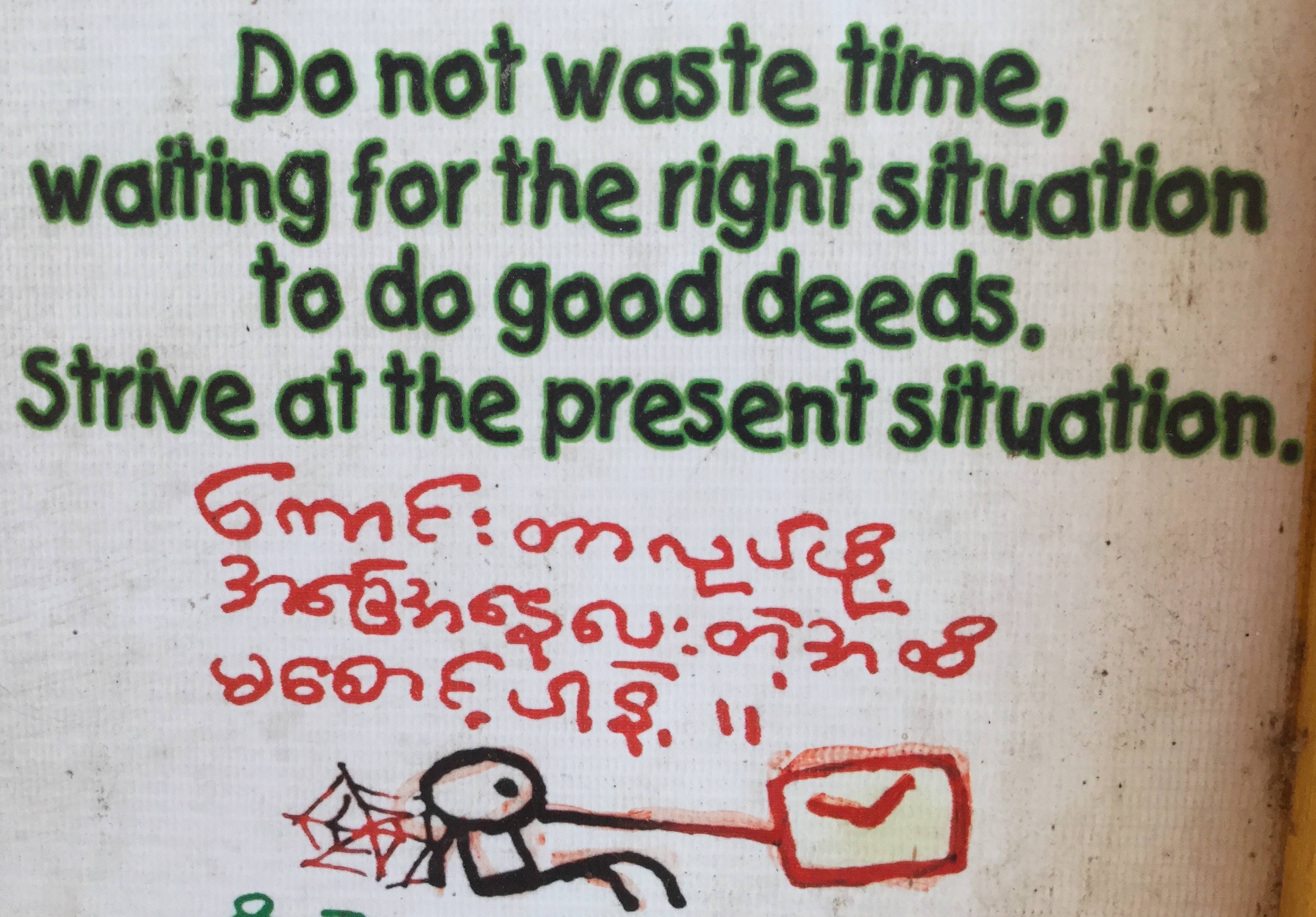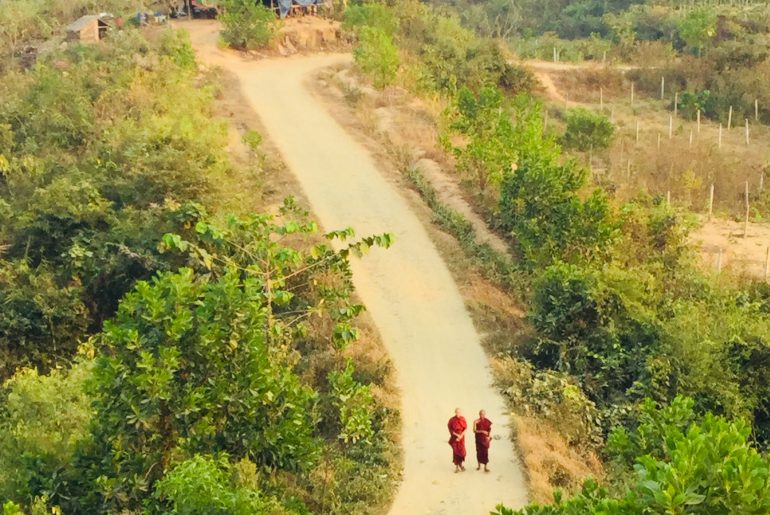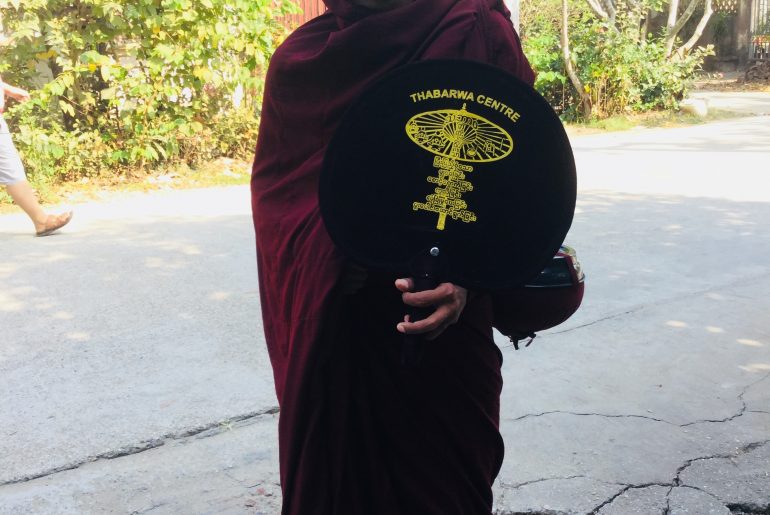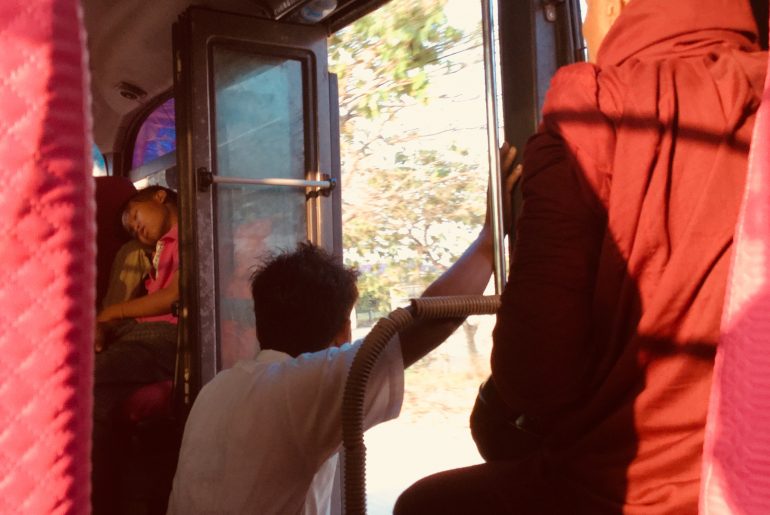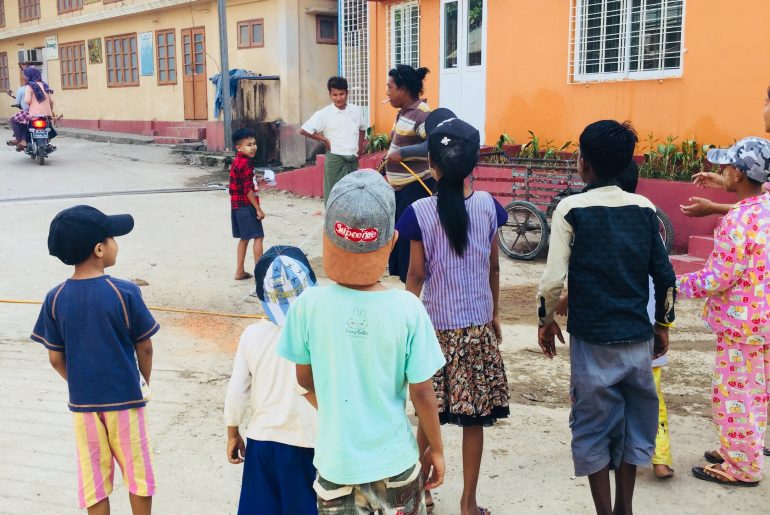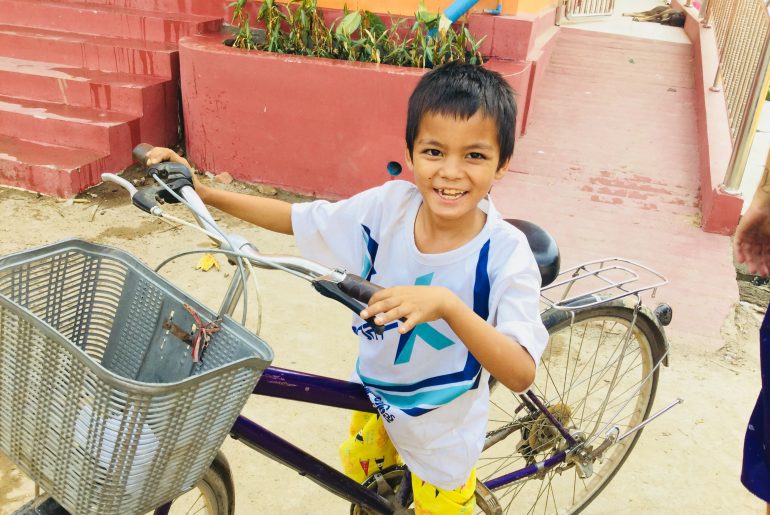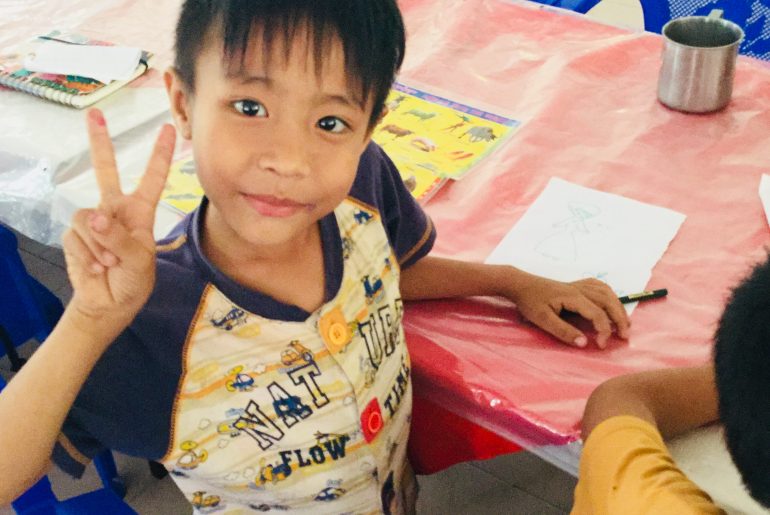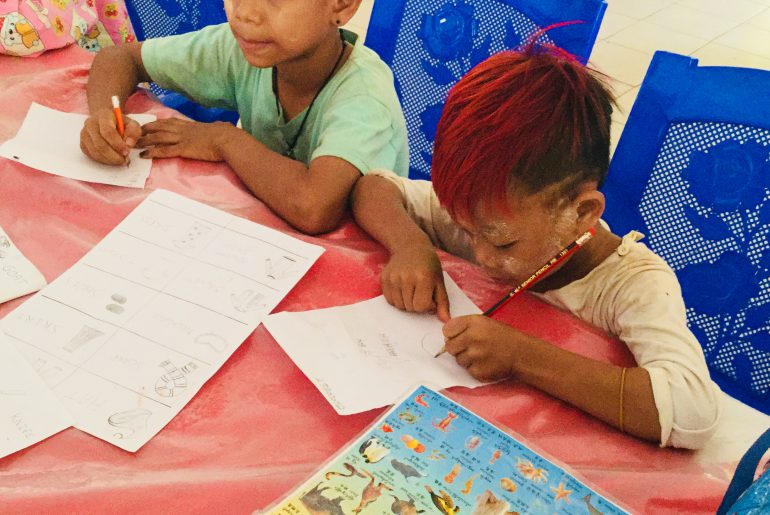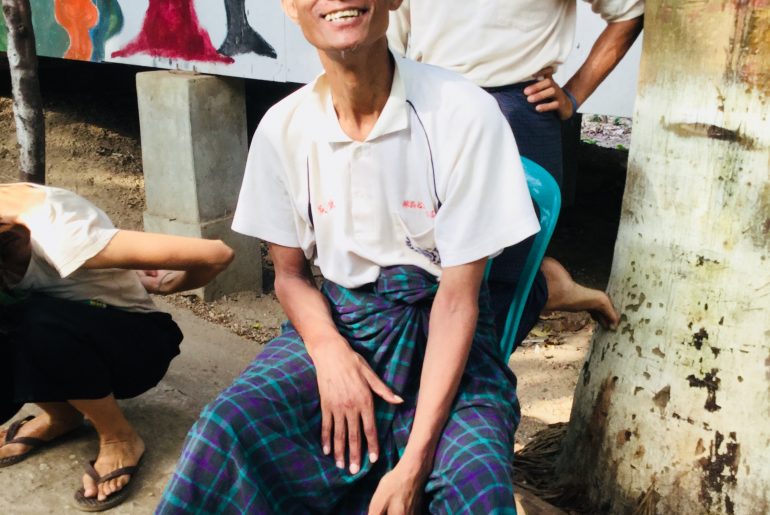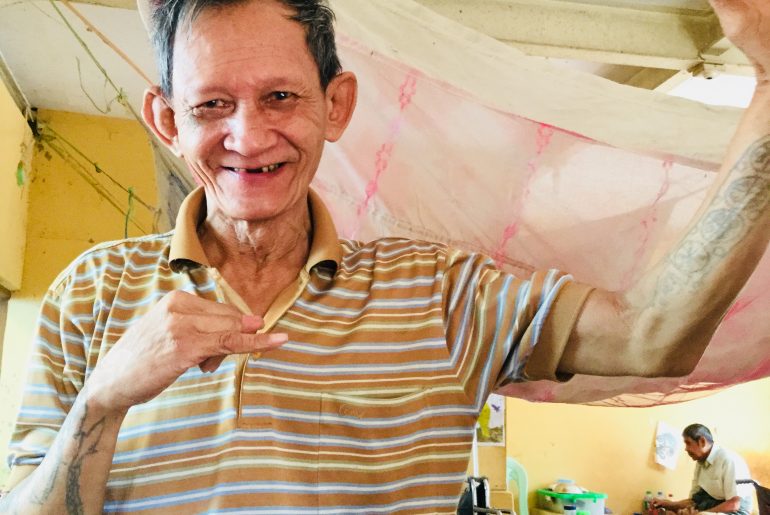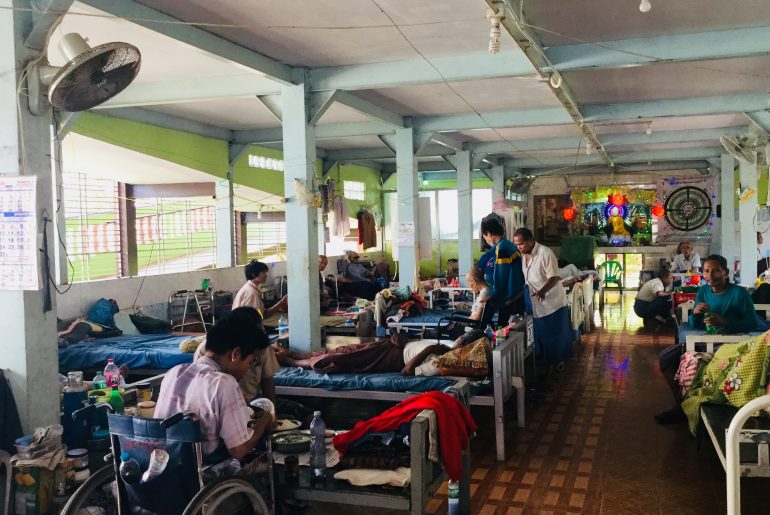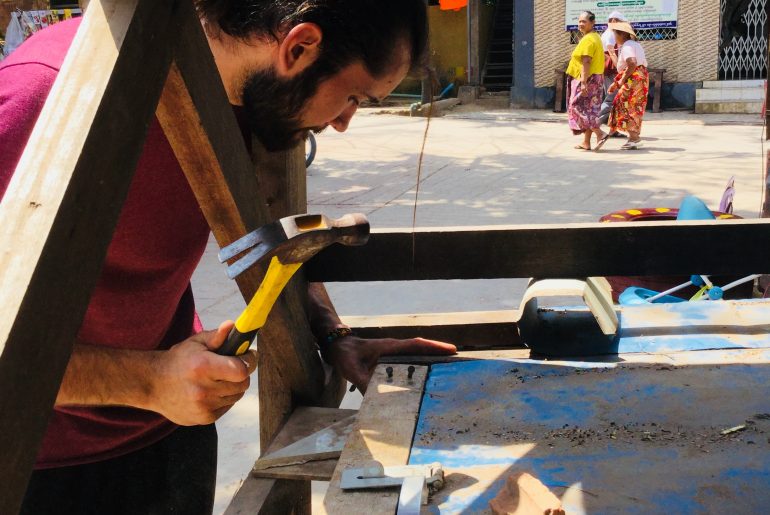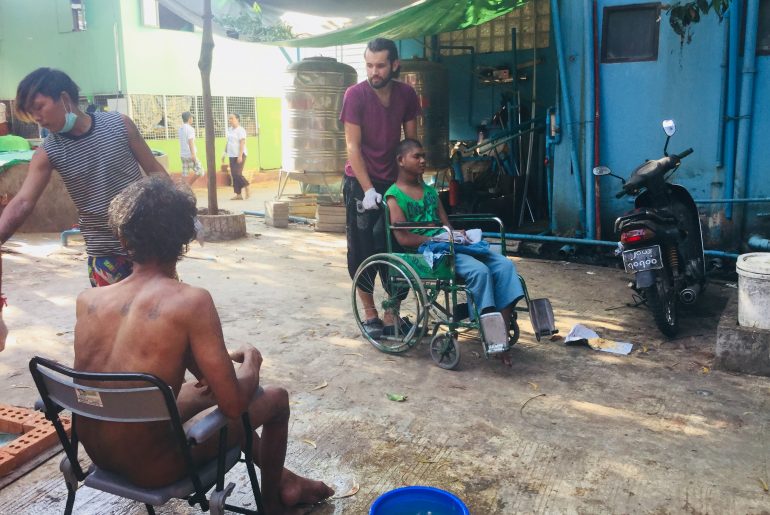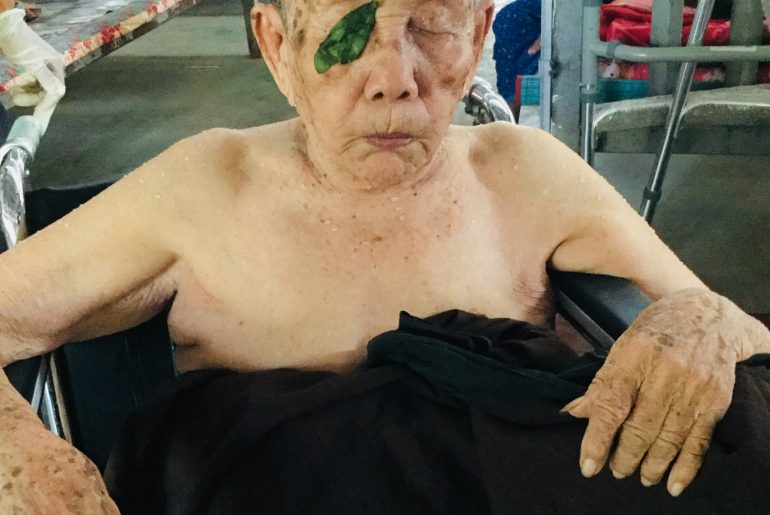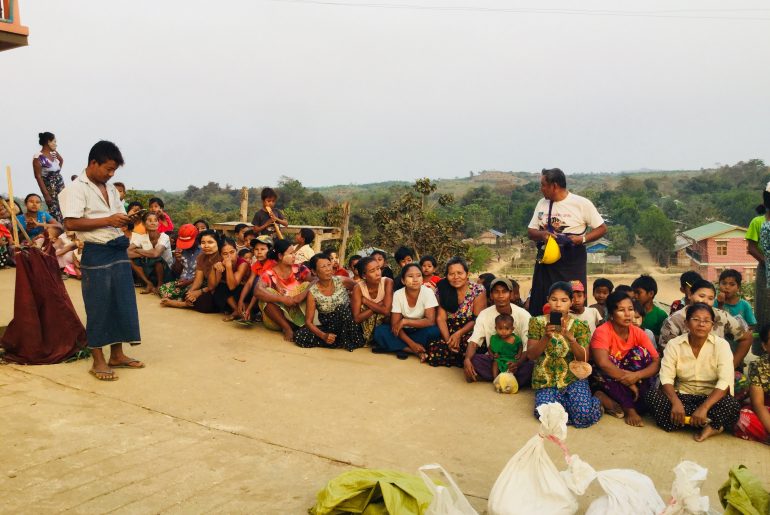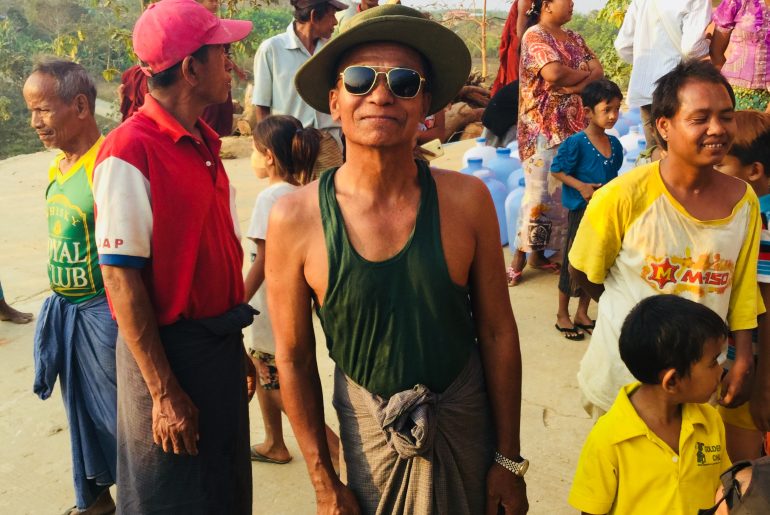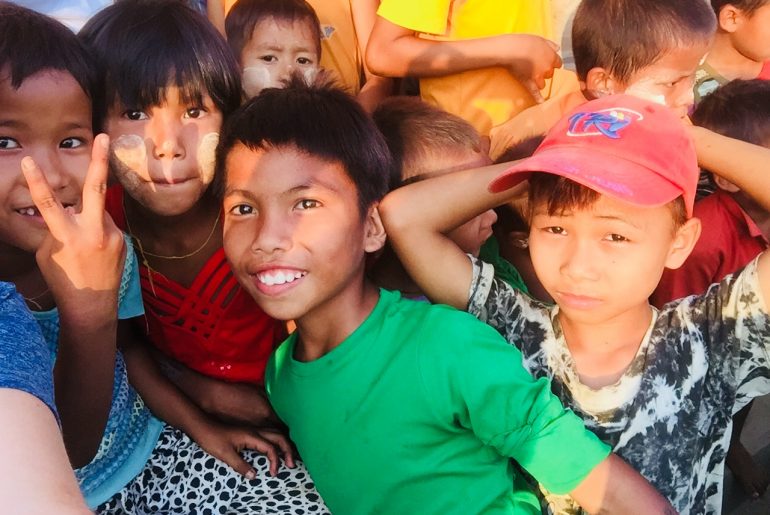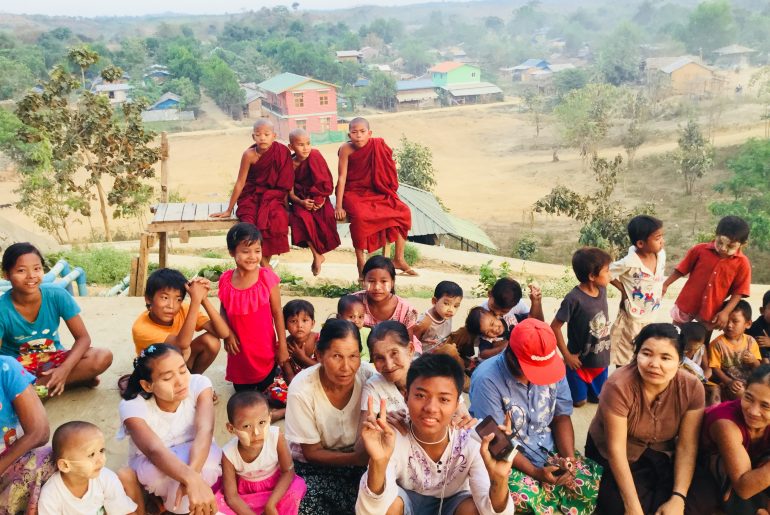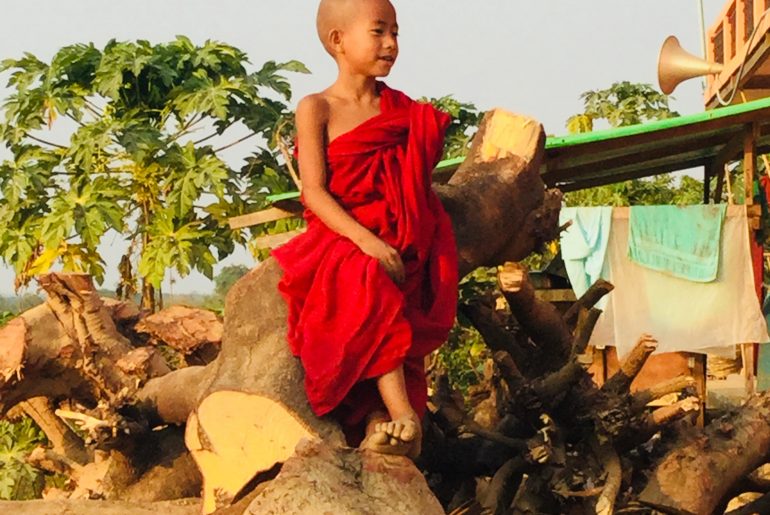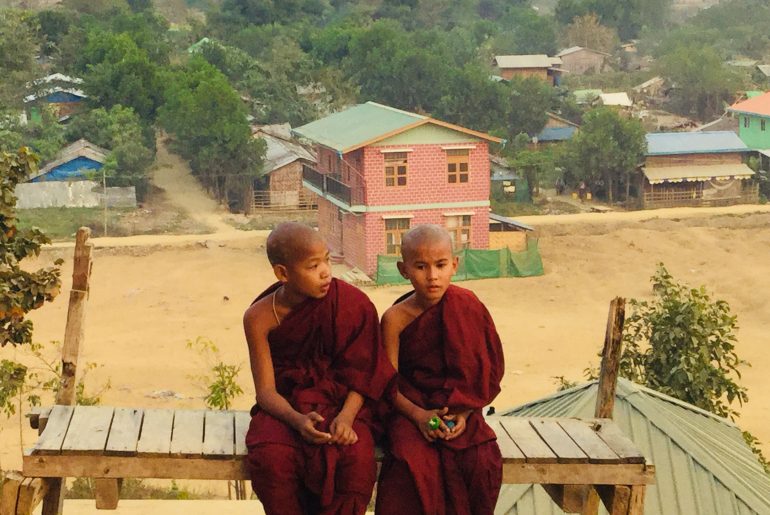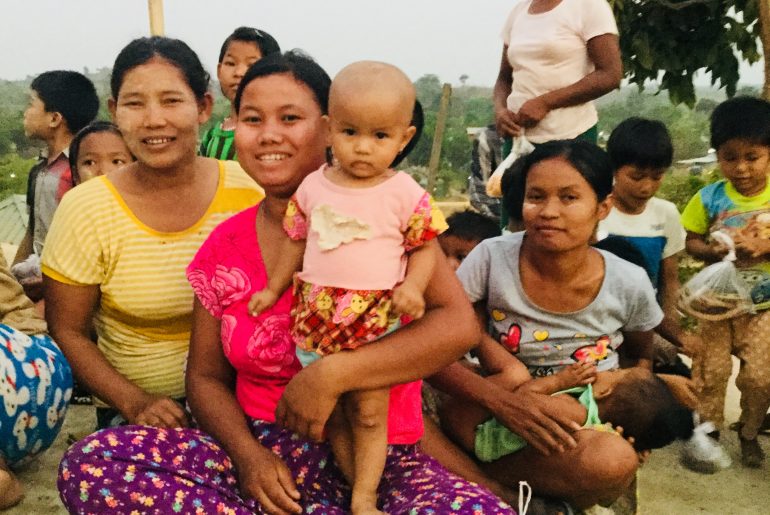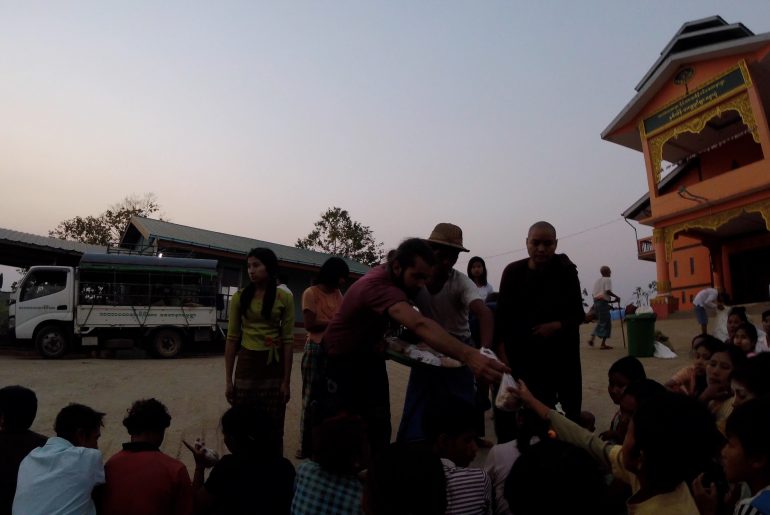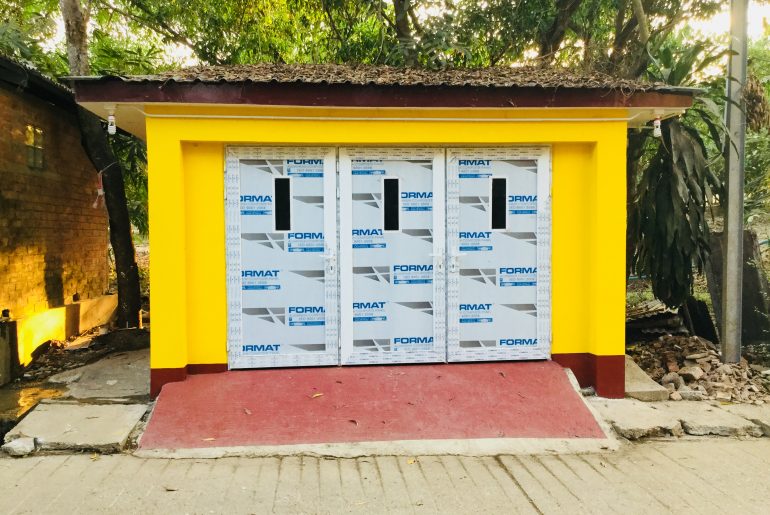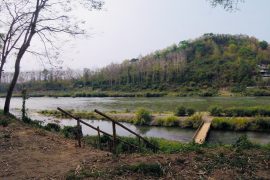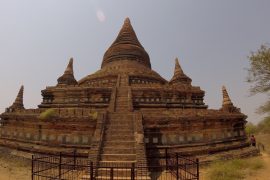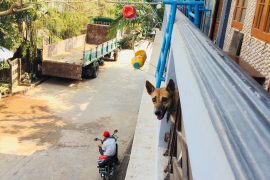Click on the pictures to get a better view and to scroll through easier. We also have more pictures on Facebook.
At the center, there are different activities to do throughout the day to practice good deeds. Each night we met at 7 to decide which activities we wanted to participate in the following day. There is rice washing, patient care, patient washing, make them move (being creative with movement), physiotherapy, teaching kids/adults English, learning Burmese from a resident, cooking dinner for all volunteers, pagoda party (taking patients outside to the pagoda to pray), and ALMS (collecting donations). The center provides gloves, face masks, disinfectant solutions, etc. to protect the volunteers and the patients. Also, a volunteer coordinator is always present to show the right procedure and to answer any questions you might have.
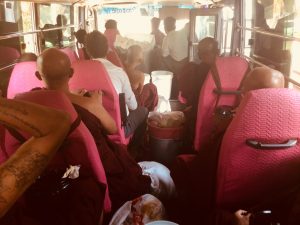 The first day of volunteering, Jesse and I both signed up for ALMS. Where we go into town in the early morning with the monks and nuns and collect donations from the community. It’s pretty unreal to be sitting in a bus full of Burmese Monks. We had just watched this happen down our street in front of our guesthouse and now we’re being a part of it, hands on. As I rode on the bus full of monks, I had this image in my mind as if I was a reporter on the BBC channel about to do some wild story. Never would I have imagined being in Burma, let alone doing this, but that’s the fun part about not planning a trip too much. If you just go with the flow and take chances, you never know where you’ll land. An hour later I stepped off the bus into a town I didn’t even know the name of. I was given a large empty rice bag that would soon be used to collect an assortment of donations. Coffee, rice, fruit, cookies, vegetables, drinks, cooking oil, soy milk, and anything else locals wished to share, everything was accepted. Another volunteer was given a collection bowl to carry for the money donations. Jesse and I were separated into different buses, I thought we would end up meeting at the same place but he never came. It turned out that each bus went to a different town.
The first day of volunteering, Jesse and I both signed up for ALMS. Where we go into town in the early morning with the monks and nuns and collect donations from the community. It’s pretty unreal to be sitting in a bus full of Burmese Monks. We had just watched this happen down our street in front of our guesthouse and now we’re being a part of it, hands on. As I rode on the bus full of monks, I had this image in my mind as if I was a reporter on the BBC channel about to do some wild story. Never would I have imagined being in Burma, let alone doing this, but that’s the fun part about not planning a trip too much. If you just go with the flow and take chances, you never know where you’ll land. An hour later I stepped off the bus into a town I didn’t even know the name of. I was given a large empty rice bag that would soon be used to collect an assortment of donations. Coffee, rice, fruit, cookies, vegetables, drinks, cooking oil, soy milk, and anything else locals wished to share, everything was accepted. Another volunteer was given a collection bowl to carry for the money donations. Jesse and I were separated into different buses, I thought we would end up meeting at the same place but he never came. It turned out that each bus went to a different town.
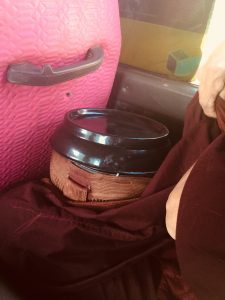 There was a small truck at the beginning just before us with a loudspeaker announcing to the community that we were walking through. We walked around town for about an hour and a half, barefoot. I found it very peaceful. I also learned that my feet are generally pretty soft on the bottoms, so if I stepped on a rock at the right angle, it didn’t feel too well. Jesse and I both witnessed many locals who clearly didn’t have a lot of money yet they donated what they could, usually, a bowl of uncooked white rice often topped off with a questionable amount of money. There were two ladies that came out of their houses with stacks of money giving some to each of the 15 monks. Some locals also donated cooked rice and other dishes. A spoonful of the rice was given to the head monk in the bowl that was carried around his neck. The rest would be placed in a bin which would later be eaten for lunch, same goes for the vegetables. As locals walked up to us first they took their shoes off and walked toward the head monk with their item in hand for a blessing. After having the item blessed by the monks, the donation would be placed into either the money bowl, empty rice bags or bins for cooked food. There were times when children would be the ones to hand over the donations, it was really sweet to witness.
There was a small truck at the beginning just before us with a loudspeaker announcing to the community that we were walking through. We walked around town for about an hour and a half, barefoot. I found it very peaceful. I also learned that my feet are generally pretty soft on the bottoms, so if I stepped on a rock at the right angle, it didn’t feel too well. Jesse and I both witnessed many locals who clearly didn’t have a lot of money yet they donated what they could, usually, a bowl of uncooked white rice often topped off with a questionable amount of money. There were two ladies that came out of their houses with stacks of money giving some to each of the 15 monks. Some locals also donated cooked rice and other dishes. A spoonful of the rice was given to the head monk in the bowl that was carried around his neck. The rest would be placed in a bin which would later be eaten for lunch, same goes for the vegetables. As locals walked up to us first they took their shoes off and walked toward the head monk with their item in hand for a blessing. After having the item blessed by the monks, the donation would be placed into either the money bowl, empty rice bags or bins for cooked food. There were times when children would be the ones to hand over the donations, it was really sweet to witness.
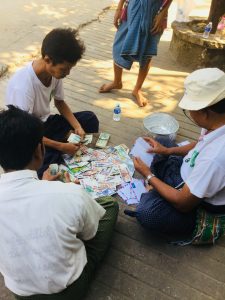 This was very humbling to see the donations collected in just a little over an hour and the beautiful thing is that this happens daily in different locations. At the end of each ALMS session, all of the money is dumped onto the sidewalk and counted before getting into the bus. Often water, fruit, and other snacks are donated and when you get on the bus the monks hand you some goodies for yourself. Then we headed back to the center with all of the donations. The uncooked rice gets set aside for washing the next morning and all of the cooked food is served for anyone who would like free lunch. These are the donations along with uncooked food that all 3,000+ people at the center eat. Since ALMS is something that continues to happen daily, there is a constant flow of food coming into the center. We ate lunch the first day then decided to order from the local tea shop for the rest of our time at Thabarwa. In Asia often meat is hidden in dishes or fish sauce is used so when you have cooked food from many different people it’s best for Vegans to eat elsewhere. From what I’ve experienced through ALMS, Burmese culture is very rich in morals, traditional beliefs and their understanding of karma. Their actions are reflected based on their belief that what you do now will have either a positive or negative effect on both your present, future and your next life.
This was very humbling to see the donations collected in just a little over an hour and the beautiful thing is that this happens daily in different locations. At the end of each ALMS session, all of the money is dumped onto the sidewalk and counted before getting into the bus. Often water, fruit, and other snacks are donated and when you get on the bus the monks hand you some goodies for yourself. Then we headed back to the center with all of the donations. The uncooked rice gets set aside for washing the next morning and all of the cooked food is served for anyone who would like free lunch. These are the donations along with uncooked food that all 3,000+ people at the center eat. Since ALMS is something that continues to happen daily, there is a constant flow of food coming into the center. We ate lunch the first day then decided to order from the local tea shop for the rest of our time at Thabarwa. In Asia often meat is hidden in dishes or fish sauce is used so when you have cooked food from many different people it’s best for Vegans to eat elsewhere. From what I’ve experienced through ALMS, Burmese culture is very rich in morals, traditional beliefs and their understanding of karma. Their actions are reflected based on their belief that what you do now will have either a positive or negative effect on both your present, future and your next life.
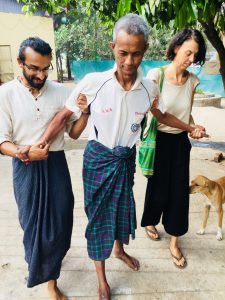 Physiotherapy is another activity I chose to do, it’s mainly helping the patients stretch, do movement exercises and walking. Some have lost the ability to walk on their own because of an accident or a stroke and they need you to slowly help guide them along by holding their hands and under their arms. The patients are very sweet and show so much gratitude for helping them. Somedays they can be very stubborn if they don’t want to do something you will know because they will throw a minor fit about it. There is a language barrier but you can use your hands more to communicate to see how they are feeling, thumbs up is good, when they hold their hand out sideways and move it back and forth in a rocking motion that means they aren’t doing so well. After doing some stretching we took two patients to the tea shop to relax and get them out of their beds. Many of the patients sit or lay in their beds all day and have nothing to do so even something as simple as walking them 20 feet to the tea shop to sit, drink tea and people watch is a special time for them. There are wheelchairs all around to borrow to push some patients throughout the center. Volunteers are encouraged to do this daily. There are some small hills so it’s often hard for patients in wheelchairs to go up them on their own. I really enjoyed this activity and realize how fulfilling it is to see the smiles on their faces when they push themselves to do the exercises and practice taking steps again.
Physiotherapy is another activity I chose to do, it’s mainly helping the patients stretch, do movement exercises and walking. Some have lost the ability to walk on their own because of an accident or a stroke and they need you to slowly help guide them along by holding their hands and under their arms. The patients are very sweet and show so much gratitude for helping them. Somedays they can be very stubborn if they don’t want to do something you will know because they will throw a minor fit about it. There is a language barrier but you can use your hands more to communicate to see how they are feeling, thumbs up is good, when they hold their hand out sideways and move it back and forth in a rocking motion that means they aren’t doing so well. After doing some stretching we took two patients to the tea shop to relax and get them out of their beds. Many of the patients sit or lay in their beds all day and have nothing to do so even something as simple as walking them 20 feet to the tea shop to sit, drink tea and people watch is a special time for them. There are wheelchairs all around to borrow to push some patients throughout the center. Volunteers are encouraged to do this daily. There are some small hills so it’s often hard for patients in wheelchairs to go up them on their own. I really enjoyed this activity and realize how fulfilling it is to see the smiles on their faces when they push themselves to do the exercises and practice taking steps again.
 Patient care is definitely the hardest activity to choose but the one that will stick with you the most. I’m going to go into details so that you can fully understand. There were 4 main patients to take care of. One man was paralyzed from the waist down with minimal use of his arms. Over time he’s developed bed sores so along with physiotherapy he also needs special care with changing the bandages, his diaper, and bathing. He is the sweetest man, his eyes are very deep and even though his suffering and pain he has a smile on his face and is very grateful for the help. The main problem with the bed sores is that he doesn’t have a long-term person there to push him to his side for a few hours and then roll him back to relieve some of the pressure on his sores. If you roll him to his side he doesn’t stay for long because his hip begins to hurt or he loses stability, so a constant check on him is necessary. There are nurses that apparently are very busy but every time I see them they seem to be on their phones. It’s sad that something so simple isn’t being done, his sores are taking much longer to heal because he isn’t being rolled to his side enough. The second patient is also paralyzed with mostly healed bed sores so the process is similar. The third was born with a genetic skin disease where his legs are permanently stiff and cannot be bent open, his arms are stiff but have a little more flexibility than his legs but it is often very difficult to change his diaper and get him dressed. He has bed sores and is full of lumps and bumps all over every inch of his entire body which is creating permanent pain. I think he’s in his 60s but the appearance of his skin could just make him look much older, I couldn’t imagine living 60 years in his condition. No matter what amount of pain he was in he still had a smile on his face. I don’t think I’ve ever been in the presence of such a strong-willed person before. The fourth patient is a woman that had breast cancer. Both breasts were removed but there was an issue with surgery and her entire chest is burnt. I won’t go into details but it’s pretty severe and she isn’t receiving the proper care she needs. Since she’s living at the meditation center and it’s a Buddhist culture, pain medicine isn’t being used and she is in excruciating pain daily. It’s a little strange because we are told that meditation is one of the main solutions for her healing. Seeing her suffering you can clearly tell that she needs an actual doctor and it’s so hard to witness because you can’t do anything about it. At the moment nothings infected because it’s cleaned daily, but just using a simple water solution and a clean bandage are not going to heal it. I’m not so sure if she will ever fully recover and if it does get infected I fear there is a chance that it could result in her death. Seeing this woman along with the others has shown me how strong Burmese people are. In America, we’re so quick to go to the doctors for aches, pains, colds and other minor health issues. I don’t think I know anyone that would be able to handle the pain these people experience in their daily lives. I know one thing, I definitely wouldn’t want to get hurt in Burma. From what I’m seeing with both volunteers and patients their healthcare is not the best, but then again Thabarwa isn’t a legit hospital either.
Patient care is definitely the hardest activity to choose but the one that will stick with you the most. I’m going to go into details so that you can fully understand. There were 4 main patients to take care of. One man was paralyzed from the waist down with minimal use of his arms. Over time he’s developed bed sores so along with physiotherapy he also needs special care with changing the bandages, his diaper, and bathing. He is the sweetest man, his eyes are very deep and even though his suffering and pain he has a smile on his face and is very grateful for the help. The main problem with the bed sores is that he doesn’t have a long-term person there to push him to his side for a few hours and then roll him back to relieve some of the pressure on his sores. If you roll him to his side he doesn’t stay for long because his hip begins to hurt or he loses stability, so a constant check on him is necessary. There are nurses that apparently are very busy but every time I see them they seem to be on their phones. It’s sad that something so simple isn’t being done, his sores are taking much longer to heal because he isn’t being rolled to his side enough. The second patient is also paralyzed with mostly healed bed sores so the process is similar. The third was born with a genetic skin disease where his legs are permanently stiff and cannot be bent open, his arms are stiff but have a little more flexibility than his legs but it is often very difficult to change his diaper and get him dressed. He has bed sores and is full of lumps and bumps all over every inch of his entire body which is creating permanent pain. I think he’s in his 60s but the appearance of his skin could just make him look much older, I couldn’t imagine living 60 years in his condition. No matter what amount of pain he was in he still had a smile on his face. I don’t think I’ve ever been in the presence of such a strong-willed person before. The fourth patient is a woman that had breast cancer. Both breasts were removed but there was an issue with surgery and her entire chest is burnt. I won’t go into details but it’s pretty severe and she isn’t receiving the proper care she needs. Since she’s living at the meditation center and it’s a Buddhist culture, pain medicine isn’t being used and she is in excruciating pain daily. It’s a little strange because we are told that meditation is one of the main solutions for her healing. Seeing her suffering you can clearly tell that she needs an actual doctor and it’s so hard to witness because you can’t do anything about it. At the moment nothings infected because it’s cleaned daily, but just using a simple water solution and a clean bandage are not going to heal it. I’m not so sure if she will ever fully recover and if it does get infected I fear there is a chance that it could result in her death. Seeing this woman along with the others has shown me how strong Burmese people are. In America, we’re so quick to go to the doctors for aches, pains, colds and other minor health issues. I don’t think I know anyone that would be able to handle the pain these people experience in their daily lives. I know one thing, I definitely wouldn’t want to get hurt in Burma. From what I’m seeing with both volunteers and patients their healthcare is not the best, but then again Thabarwa isn’t a legit hospital either.
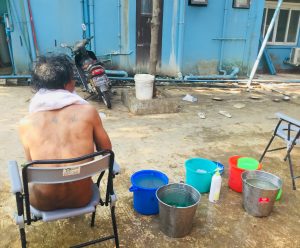 Patient washing was my favorite activity. There are quite a few different buildings with groups of patients, some buildings are all men, some all women and some are a mixture filled with those that were once homeless. Each day we went to a different building, bringing wheelchairs, buckets, bowls, soap, cloths, and towels and we washed anyone that needed or wanted washing. I’ve never washed a grown adult before but it didn’t really seem weird to me either. My thoughts immediately were, someday this could be me, Jesse or someone in my family and I would want them to be clean and taken care of. Once you reach a certain age and your body begins breaking down or you develop a sickness, you become similar to a baby again. Helpless and in need of care in order to be happy and feel loved. The hard part is dressing them if you’ve ever struggled to get clothes on a child or baby, try a grown adult that can’t assist you. It’s a challenge, especially if they lost function in their arms or legs and they have stiffness in their muscles. It’s like trying to bend a wooden board into the sleeve of a t-shirt, there is a method though. There were many volunteers that wouldn’t try this activity, but to me it was very fulfilling getting patients who clearly needed a bath, washing them, clothing them, then wheeling them back to their bed with smiles on their faces. After bathing over 25-30 patients you are partially wet, sweaty and need a shower yourself. The shower after feels pretty satisfying, as you wash your own body you feel energized and cleansed. There are 100s of patients and without this, as an activity, many would go without being bathed for days, weeks, maybe even months. It really is needed and I have developed so much gratitude toward all of the nurses and people that work in human services or with people that have disabilities. I realize I would have been great going into a patient care type of field. I did this activity the most because it was needed the most in my opinion and I had fun. The group of women in the all-women building are really fun to spend time with and you always walk away feeling happier.
Patient washing was my favorite activity. There are quite a few different buildings with groups of patients, some buildings are all men, some all women and some are a mixture filled with those that were once homeless. Each day we went to a different building, bringing wheelchairs, buckets, bowls, soap, cloths, and towels and we washed anyone that needed or wanted washing. I’ve never washed a grown adult before but it didn’t really seem weird to me either. My thoughts immediately were, someday this could be me, Jesse or someone in my family and I would want them to be clean and taken care of. Once you reach a certain age and your body begins breaking down or you develop a sickness, you become similar to a baby again. Helpless and in need of care in order to be happy and feel loved. The hard part is dressing them if you’ve ever struggled to get clothes on a child or baby, try a grown adult that can’t assist you. It’s a challenge, especially if they lost function in their arms or legs and they have stiffness in their muscles. It’s like trying to bend a wooden board into the sleeve of a t-shirt, there is a method though. There were many volunteers that wouldn’t try this activity, but to me it was very fulfilling getting patients who clearly needed a bath, washing them, clothing them, then wheeling them back to their bed with smiles on their faces. After bathing over 25-30 patients you are partially wet, sweaty and need a shower yourself. The shower after feels pretty satisfying, as you wash your own body you feel energized and cleansed. There are 100s of patients and without this, as an activity, many would go without being bathed for days, weeks, maybe even months. It really is needed and I have developed so much gratitude toward all of the nurses and people that work in human services or with people that have disabilities. I realize I would have been great going into a patient care type of field. I did this activity the most because it was needed the most in my opinion and I had fun. The group of women in the all-women building are really fun to spend time with and you always walk away feeling happier.
Jesse and I taught English to the children 1 day. They are very cute and eager to learn. Although teaching is my field I saw how important some of the other activities were that I decided to let the other volunteers do the teaching. Jesse mainly did work on fixing a few doors, getting the golf cart running again and fixing wheelchairs. I pushed him to step out of his comfort zone and he helped with patient washing 3 days in a row!
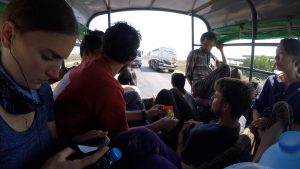 One of the days we were there we had the opportunity to travel 3 hours one way to go visit an animal shelter that the center owns. We were told there would be 100s of dogs, a few bears, elephants, and snakes, so I immediately wanted to do it. We waited out front our dorm for the bus, by bus I mean open-air truck with two long hard seats like bleachers, it usually seats about 20 or 25, including the floor. We originally had 15 people interested but once some of them saw the riding conditions they bailed. There were about 20 large water cooler jugs to put in the back with us, along with 3 or 4 large rice bags filled with food and two large size garbage bins, also with food. At the time none of us understood what all that water and food was for but we would soon find out.
One of the days we were there we had the opportunity to travel 3 hours one way to go visit an animal shelter that the center owns. We were told there would be 100s of dogs, a few bears, elephants, and snakes, so I immediately wanted to do it. We waited out front our dorm for the bus, by bus I mean open-air truck with two long hard seats like bleachers, it usually seats about 20 or 25, including the floor. We originally had 15 people interested but once some of them saw the riding conditions they bailed. There were about 20 large water cooler jugs to put in the back with us, along with 3 or 4 large rice bags filled with food and two large size garbage bins, also with food. At the time none of us understood what all that water and food was for but we would soon find out.
After everything was put in the truck there was enough room to fit maybe 5 people comfortably, we still left with 12 people. If only you could have seen Jesse’s face, he gave me the are you kidding me look. The trip reminded me of both a time in Haiti riding in the back of the truck through the mountains and the dust filled roads in Ghana with the occasional dust storm in your face. It might be strange to say but I love these type of rides. Although they are dirty, extremely bumpy and loud, there’s something special about listening to a good playlist and having the wind in your hair.
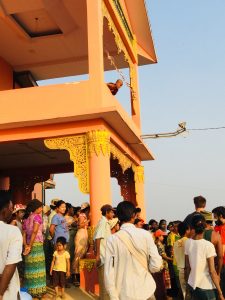 So after a few random stops, we make it to the shelter and we pull up to a building where there are over 100 people ready to greet us. First, we parked and dropped off all of the water we brought then we got back in the truck and drove down the street to another building. One of the nuns did some talking and then we were off. We passed a bear and some dogs in cages and there was a monkey chained to the ledge of the building, but that was all of the animals we saw. Apparently, the bear was rescued from a bad situation but since this is not his natural habitat he can’t be let loose anywhere. It reminded me of when I was in South Korea and my school I was teaching at had a “zoo”, which turned out to be only a few deer trapped in a cage. When you hear animal shelter or zoo you get this general image in your mind of what you think it might be like, when in another country it seems best to just drop all previous images because you really never know what you’re stepping into.
So after a few random stops, we make it to the shelter and we pull up to a building where there are over 100 people ready to greet us. First, we parked and dropped off all of the water we brought then we got back in the truck and drove down the street to another building. One of the nuns did some talking and then we were off. We passed a bear and some dogs in cages and there was a monkey chained to the ledge of the building, but that was all of the animals we saw. Apparently, the bear was rescued from a bad situation but since this is not his natural habitat he can’t be let loose anywhere. It reminded me of when I was in South Korea and my school I was teaching at had a “zoo”, which turned out to be only a few deer trapped in a cage. When you hear animal shelter or zoo you get this general image in your mind of what you think it might be like, when in another country it seems best to just drop all previous images because you really never know what you’re stepping into.
We made our way back to the original location and the road was lined with people sitting on the ground. At first, we had no idea what we were doing there but then all of the bins and rice bags came out of the truck and items were slowly dispersed between all of the people of the village. There was an assortment of food, rice, sugar, potatoes, beans…the list is endless, even the children received something. There were lots of smiling faces and many people wanted their picture taken with their children. So, what we thought was a trip to an animal shelter turned out to be more of a missions trip to deliver donations, which was a wonderful experience but I was really looking forward to elephants, a bear and other animals like we were told. This was a great lesson about having expectations and having it turn out complete opposite of what you thought.
After making one more pit stop to cut up a watermelon to share, we were off on the 3-hour journey back to the center. Burmese people love watermelon, as you drive you can see hundreds of watermelons along the roadside. This experience was pretty interesting considering all 12 of us thought we were going to see some animals. It felt nice to hand out food even though I had nothing to do with the donations. It reminded me of being in Ghana and bringing all the school supplies, no matter what each person received it was all appreciated and they are eternally grateful.
Not one of these activities could happen without the help of the volunteers, especially the long-term volunteers that have been at Thabarwa for months/years. After a week I wondered how they could live here long term but then I fully experienced the work and good deeds they are doing and I understood. Without their determination and compassion, the patients would lose all of their individual care and would likely develop more sickness. It’s been a week since leaving Thabarwa and I think of the patients every day, I could see why volunteers go back again. The people you care for really leave an imprint on your soul and make you question what you are doing to lend a hand where it is needed. My gratitude extends to all of the people that work with individuals like these, you are highly valued and appreciated.
Our time in Thabarwa volunteering was more than I imagined it would be. I walked away feeling an even greater sense of compassion and understanding than I had when I arrived. I’m reminded of the story of Siddhartha when he left the palace and had a glimpse of old age, sickness, and death for the first time. When you’re around people that are ill or reaching the brink of death, you naturally reflect on your own life and health. I’ve been reading books on Buddhism for years and have been a believer in reincarnation since as far back as I can remember so I’ve come to terms with death and dying and understand that it’s just another transition. Thabarwa was created out of love and compassion for all beings and I am so grateful to have had the opportunity to practice good deeds and spend time helping those that need it the most. These experiences will remain in my heart for many years to come. A special thanks to Sayadaw Ottamasara for being the light for so many others, your kindness is infinite.
